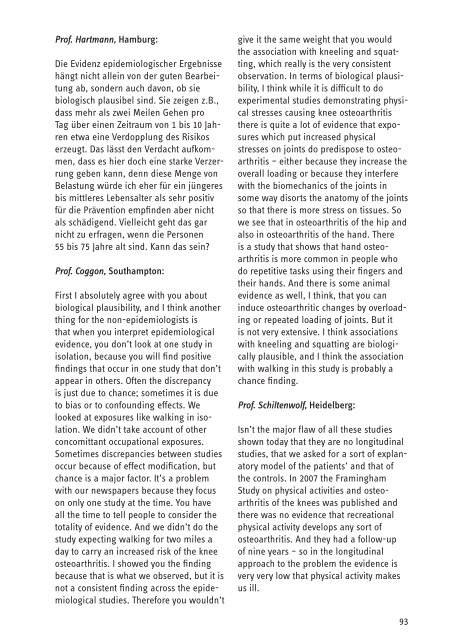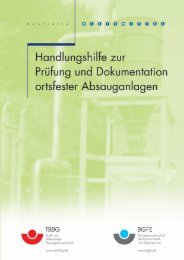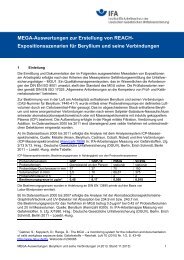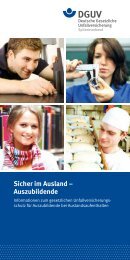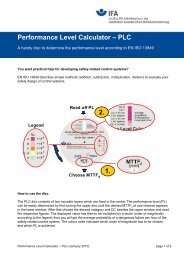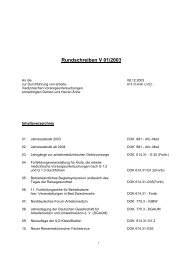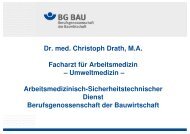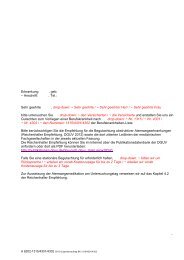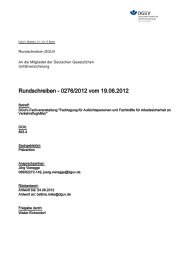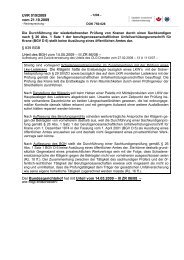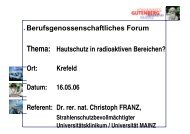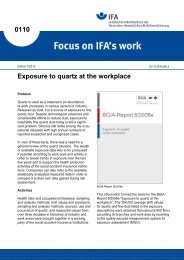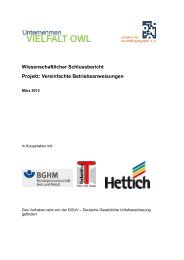Interdisziplinäres Fachgespräch „Gonarthrose“ - Deutsche ...
Interdisziplinäres Fachgespräch „Gonarthrose“ - Deutsche ...
Interdisziplinäres Fachgespräch „Gonarthrose“ - Deutsche ...
Erfolgreiche ePaper selbst erstellen
Machen Sie aus Ihren PDF Publikationen ein blätterbares Flipbook mit unserer einzigartigen Google optimierten e-Paper Software.
Prof. Hartmann, Hamburg:<br />
Die Evidenz epidemiologischer Ergebnisse<br />
hängt nicht allein von der guten Bearbeitung<br />
ab, sondern auch davon, ob sie<br />
biologisch plausibel sind. Sie zeigen z.B.,<br />
dass mehr als zwei Meilen Gehen pro<br />
Tag über einen Zeitraum von 1 bis 10 Jahren<br />
etwa eine Verdopplung des Risikos<br />
erzeugt. Das lässt den Verdacht aufkommen,<br />
dass es hier doch eine starke Verzerrung<br />
geben kann, denn diese Menge von<br />
Belastung würde ich eher für ein jüngeres<br />
bis mittleres Lebensalter als sehr positiv<br />
für die Prävention empfi nden aber nicht<br />
als schädigend. Vielleicht geht das gar<br />
nicht zu erfragen, wenn die Personen<br />
55 bis 75 Jahre alt sind. Kann das sein?<br />
Prof. Coggon, Southampton:<br />
First I absolutely agree with you about<br />
biological plausibility, and I think another<br />
thing for the non-epidemiologists is<br />
that when you interpret epidemiological<br />
evidence, you don’t look at one study in<br />
isolation, because you will fi nd positive<br />
fi ndings that occur in one study that don’t<br />
appear in others. Often the discrepancy<br />
is just due to chance; sometimes it is due<br />
to bias or to confounding effects. We<br />
looked at exposures like walking in isolation.<br />
We didn’t take account of other<br />
concomittant occupational exposures.<br />
Sometimes discrepancies between studies<br />
occur because of effect modifi cation, but<br />
chance is a major factor. It’s a problem<br />
with our newspapers because they focus<br />
on only one study at the time. You have<br />
all the time to tell people to consider the<br />
totality of evidence. And we didn’t do the<br />
study expecting walking for two miles a<br />
day to carry an increased risk of the knee<br />
osteoarthritis. I showed you the fi nding<br />
because that is what we observed, but it is<br />
not a consistent fi nding across the epidemiological<br />
studies. Therefore you wouldn’t<br />
give it the same weight that you would<br />
the association with kneeling and squatting,<br />
which really is the very consistent<br />
observation. In terms of biological plausibility,<br />
I think while it is diffi cult to do<br />
experimental studies demonstrating physical<br />
stresses causing knee osteoarthritis<br />
there is quite a lot of evidence that exposures<br />
which put increased physical<br />
stresses on joints do predispose to osteoarthritis<br />
– either because they increase the<br />
overall loading or because they interfere<br />
with the biomechanics of the joints in<br />
some way disorts the anatomy of the joints<br />
so that there is more stress on tissues. So<br />
we see that in osteoarthritis of the hip and<br />
also in osteoarthritis of the hand. There<br />
is a study that shows that hand osteoarthritis<br />
is more common in people who<br />
do repetitive tasks using their fi ngers and<br />
their hands. And there is some animal<br />
evidence as well, I think, that you can<br />
induce osteoarthritic changes by overloading<br />
or repeated loading of joints. But it<br />
is not very extensive. I think associations<br />
with kneeling and squatting are biologically<br />
plausible, and I think the association<br />
with walking in this study is probably a<br />
chance fi nding.<br />
Prof. Schiltenwolf, Heidelberg:<br />
Isn’t the major fl aw of all these studies<br />
shown today that they are no longitudinal<br />
studies, that we asked for a sort of explanatory<br />
model of the patients’ and that of<br />
the controls. In 2007 the Framingham<br />
Study on physical activities and osteoarthritis<br />
of the knees was published and<br />
there was no evidence that recreational<br />
physical activity develops any sort of<br />
osteoarthritis. And they had a follow-up<br />
of nine years – so in the longitudinal<br />
approach to the problem the evidence is<br />
very very low that physical activity makes<br />
us ill.<br />
93


